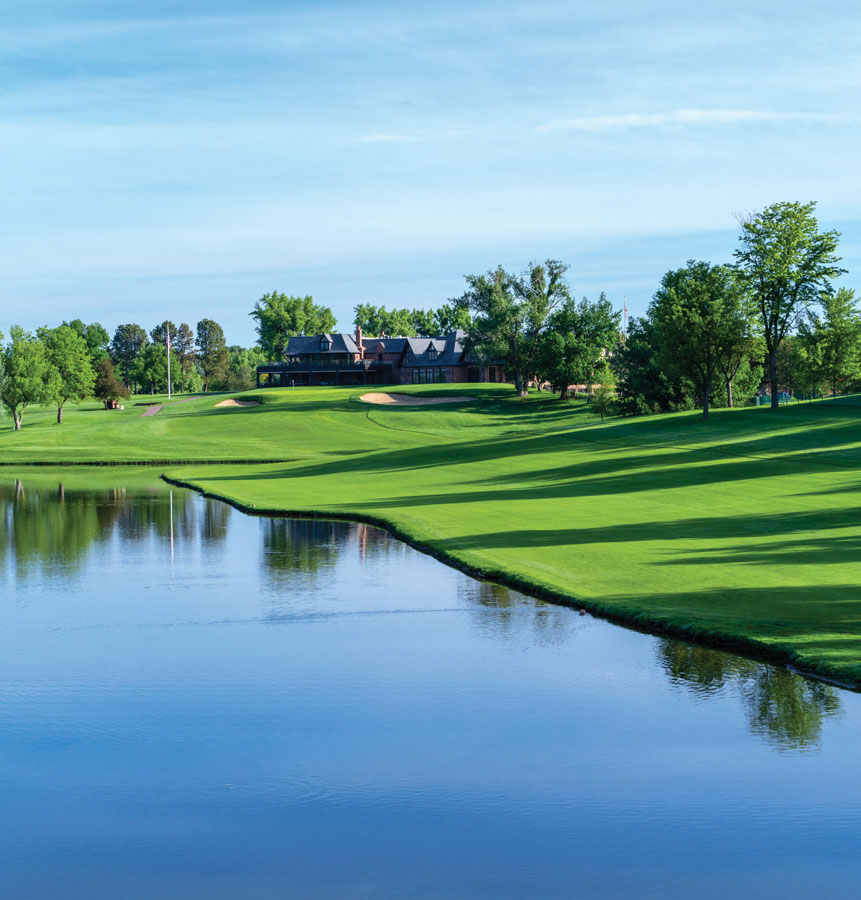A Cherry Jubilee
The U.S. Amateur visits Cherry Hills CC in August; the course is ready.
by Jon Rizzi
photography by Evan Schiller

At the 123rd U.S. Amateur Championship at Cherry Hills Country Club patrons will find themselves on hallowed ground — a 101-year-old golf course with one of golf’s finest architectural pedigrees and championship histories.
Designed by the esteemed William Flynn, the layout in 1938 became the first course west of the Mississippi to host a U.S. Open — and the last one in which the winner (Ralph Guldahl) played in a necktie. Fourteen more national championships have followed, including two U.S. Opens (1960 and ’78), two PGA Championships (’41 and ’85), a U.S. Women’s Open (2005) and three U.S. Amateurs (1990, 2012, ’23).
Each has produced its own electric moments. In the 2012 Amateur, it was Michael Weaver’s lip-out on the 18th in the championship match, which allowed unheralded Steven Fox to triumph over a field that featured the future winners of 68 PGA Tour events and seven majors.
What will this year’s Amateur deliver? The stage is set, and with no grandstands or ropes along the fairways, patrons will have intimate access to the drama.
IN LIKE FLYNN AND UP A CREEK

With abundant risk-reward options, Flynn’s parkland layout has withstood the tests of time and technology, thanks to the club’s commitment to excellence, maintenance and a long-range Flynn restoration project that Tom Doak’s Renaissance Golf Design team completed last year.
Referencing Flynn’s original drawings, the Renaissance team restored every hole on the course, adding length where appropriate to accommodate today’s game and removing more than 2,000 trees between 2005 and 2022 to improve sightlines, playability and reveal the course Flynn originally envisioned.
Flynn’s Cherry Hills layout follows the unconventional routing of Muirfield in Scotland — the front nine figure-eights on the interior of the property while the back nine runs counterclockwise along the perimeter. Its 17th hole features the first island green in the U.S., and throughout the course are influences of Pine Valley, one of the many masterpieces — others include Merion, Shinnecock and The Country Club at Brookline — on which the architect had worked.
The restoration’s capstone, the “Creek Project,” reestablished the natural meander of Little Dry Creek. To mitigate flooding, over the years the club had straightened, channelized, bouldered and rerouted the creek away from fairways and greens, rendering it less tactical than Flynn had intended. “You can see in his drawings, he was routing the holes and implementing strategy based on the hazard,” explains Renaissance’s Eric Iverson, who oversaw this part of the project. Completed this year, the project has impacted nos. 7, 8, 14, 15 and 16.
“The creek holes have all been made much tougher,” says Tom Lee, a 43-year Cherry Hills member who’s serves on the Executive Committee for the tournament and competed in the 1978 U.S. Amateur. “On any of them, if your shot’s even a little bit off, you’re in trouble.”
That’s because Cherry Hills, like most classic courses, rewards shot placement rather than shot distance, and strategy over strength.
“You can’t overpower it,” Lee explains. “On most holes you can hit irons off the tee, but most of the college kids in the Amateur play super-aggressively. Here, you need to know when to be aggressive and when to play smart. The key is keeping it in the fairway and positioning your shots so you can play the optimal angle into the green. But you need to study the course hard to know what those are.”
The 312 entrants had better do their homework.
SO WHAT’S ON THE TEST?
Cherry Hills will play at virtually the identical yardage (7,405) that it did for the 2012 U.S. Amateur (7,409) and sport its usual championship par of 71, with the 487-yard 18th played as a par 4 rather than the par 5 that members play. However, renovations made during the last 11 years — particularly on those creek holes — have added considerable challenge.
The greens, which usually stimp at 12.6 for daily play, can roll as fast as 13.6 without limiting hole locations, Head Superintendent Joshua Hester says. “We don’t have roller-coaster greens; ours are subtly deceptive.”

And while the USGA hasn’t asked Hester to narrow any fairways, no intermediate rough will border them — only a 3½- to 4-inch primary cut of dense ryegrass that will make finding the fairway even more imperative and take driver out of play on some holes.
That starts with No. 1. Although it will play at 396 yards — 50 longer than when Palmer drove the green in 1960 — at altitude most players in the field could reach the downhill par 4 with a 3-wood. To protect par, the USGA has recommended a more penal rough of four to five inches around the green on this and three other “short approach” par 4s — the well-guarded but reachable 323-yard 3rd, the 413-yard left-dogleg 7th and the 429-yard 13th.
“I’ll be anxious to see how many of the college kids pull driver on those holes,” Lee says, pointing out that those who did so in 2012 “usually walked off with 5s.”
For the Amateur, Cherry’s par-35 front nine will check in at 3,420 yards, far shorter than the 3,985-yard par-36 back — and far more benign.
Fans might see holes halved by flocks of birdies on the par 4s at Nos. 2, 3, 4 — and even the uphill 9th, although the uninitiated routinely three- and four-putt its deceptively severe green.
The 554-yard par-5 5th might yield some birdies as well. Although it played as a long par 4 during the 2014 BMW Championship, the Pine Valley-inspired hole — with its fairway interrupted by cross-bunkers, Greenwood Gulch and a massive bunker in front of the wee green — will remain a reachable par 5.
FIRST PEEK AT THE CREEK
Greenwood Gulch also defines the sinuous par-3 6th, yet it’s the water flowing on the left-dogleg par-4 7th and par-3 8th — Little Dry Creek — that defines the type of risk and reward on which a match can turn.
On the 417-yard 7th, which mimics Pine Valley’s 12th, Renaissance removed trees at the elbow of the dogleg to tempt players into reaching a long, narrow green that is 10 yards longer than it was in 2012 — but risking the dense rough and the steep, 20-foot embankment into the creek.
On the 222-yard one-shotter following it, the creek abuts the green to the right, forcing competitors to flirt with the bunkers guarding the left and right fronts of the putting surface. Players need to “hit the shelf left side of the green, and let the ball come off and down the slope,” Lee says.
MAKING THE TURN
Little Dry Creek doesn’t come back into play until the 13th hole. First players have to negotiate the 449-yard par-4 10th and the cross-bunkered 633-yard par-5 11th. Combined, the two holes now stretch 230 yards longer than Flynn designed them.
In contrast, the 201-yard 12th remains faithful to Flynn’s drawings. Tucked into the far northwest corner of the property, this postcard par 3 demands a long, angled carry over a pond. With very little room to miss right or left, “you have to hit the perfect shot into that green,” Shuck says. “And even then…Rory McIlroy four-putted there twice in the 2014 BMW Championship.”
Little Dry Creek crosses in front of the green on the 429-yard 13th, coming into play mainly for longer approaches from the fairway rough. The deeper grass encircling the green will snare shots that miss or don’t hold the putting surface. “Precision into the green is critical to winning this hole,” Shuck says.
FIGHT TO THE FINISH

The long, hard-left-dogleg 14th begins a five-hole closing gauntlet as demanding as any in golf — and that was true even before Renaissance’s “Creek Project” fortified holes 14 to 16.
Called “one of the most difficult par 4s in America,” by Ben Hogan, the 14th will play between 470 and 522 yards on different days of the championship. Whatever its yardage, the club’s PGA Head Professional Andrew Shuck calls 14 “a major swing hole, perfectly positioned in match play.”
Running along the steep bank left of the fairway, Little Dry Creek flows all the way up to the green and in front of it, taking the place of a greenside bunker and continuing along the entire left flank of the putting surface.
Lee says players lucky enough to find the rough rather than the creek off the tee may not be so fortunate. “Anyone in the deep stuff won’t get on in two unless he is super strong or has unreal swing speed.”
Iverson removed the back two bunkers on the par-3 15th to allow the creek to sidle up to the green. Like the preceding hole, 15 will play at two distances — 245 yards and 148 yards — with the tee for the latter directly behind the 14th green and adjacent to the creek. With water along its entire left side, the shorter version of the hole creates a more intimidating tee shot. “Any shot that misses the green left is just going in the creek,” Lee says.
The last creek hole, the 466-yard par 4 16th, could end many matches. Rather than bordering the green, the creek bisects the fairway, creating a left-to-right tee shot followed by the right-to-left approach. The more a player flirts with the creek, the better his angle to the green, but the greater the risk of losing a stroke to the hazard and the hole to his opponent.
Of the 63 matches played in the 2012 U.S. Amateur, only 35 made it as far as the spectacular 553-yard par-5 17th hole.
The cross-bunkered landing areas and exacting, go-for-it island green make the 17th the ideal stage for match play. Players looking to get on in two need to leave a comfortable yardage from which to hit, as the green and its surrounds are tight and unsparing.
Should a match go the distance, we’ll see how players handle the pressure of clearing the lake on the 487-yard par-4 18th while leaving themselves an unobstructed shot up the hill. Once there, they’ll putt on the same green where Arnold Palmer famously tossed his visor in 1960 — and where, on August 20, the newest champion of the oldest national amateur championship in the United States will receive the Havemeyer Trophy.
Colorado AvidGolfer Magazine is the state’s leading resource for golf and the lifestyle that surrounds it, publishing eight issues annually and proudly delivering daily content via coloradoavidgolfer.com.
Leaving Negative Thoughts Behind when You Head to the Tee Box
How does worrying impact our golf performance? What strategies can we use to manage it?
All in the Family Meal
The secret ingredient of Colorado golf course success is well-fed caddies, cooks and groundskeepers
CSU Grad Davis Bryant Discusses His Rise as a Pro Golfer
Colorado State grad Davis Bryant opens up on his path to the pros and what keeps him busy when he’s off the course


